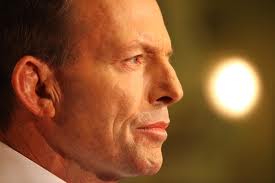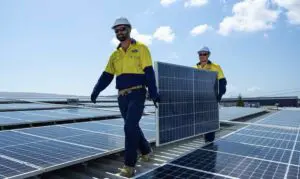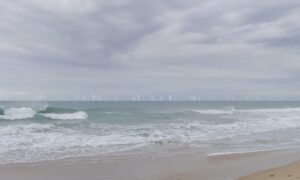Apparently, one of the few areas of bipartisan agreement in the heated politics of this country is in the area of renewables. Both major parties – Labor and the Coalition – say they support the 20 per cent renewable target, but it doesn’t actually mean what it says.
Indeed, Tony Abbott may well want to have his photo taken next to a wind farm (well, maybe not), or a solar array in the lead up to the election. Behind the scenes, however, he is under intense pressure to pull them down.
The failure of the so-called “wind fraud” rally to generate much interest among its supposed supporters or the media may indicate the influence of the “loony right” is not as great among the general public as is supposed. But the Coalition is full of rhetoric about renewables that is fed by ill-informed climate skeptic and anti-renewable energy blogs. And there is huge pressure on the Coalition from within its own ranks, the conservative state governments, the incumbent energy industry, and numerous conservative think tanks to take action to curb the expansion of renewables.
So, here are five ways that Abbott’s team could effectively kill the development of renewables in Australia. The irony is, these policies – or the mere threat that they might be imposed – are already having an impact, particularly among the financiers who have long-time horizons for their investments.
Ernst & Young last month ranked Australia as the fourth-most attractive country in the world on the basis of its suite of policies – carbon price, renewable energy target, the Clean Energy Finance Corporation, the Australian Renewable Energy Agency, and the feed in tariffs.
Yet, investment in Australia – apart from rooftop solar PV, which is now being financed almost exclusively by households and individual businesses – is stalled, because of policy uncertainty and fears that most of the building blocks cited by E&Y are in danger of being torn down or removed.
Indeed, the only projects that are likely to get financing in the next few months are those being co-funded by the CEFC, and possibly ARENA (although these will have longer lead in times). But the Coalition is so horrified by the role of the CEFC that it is putting pressure on banks to back off, and to tear up any contracts.
So here are the five ways that an Abbott Government could kill renewables:
Can the Carbon price:
Abbott has made a blood oath to do this. His ability to do so will depend on what control he has in the Senate, and/or the gumption of the remaining rump of the Labor Party to defend the policy that it introduced. That will largely depend on who and how many are left in Parliament House. If Abbott cannot repeal the carbon price, he is likely to hasten a move to a market based scheme. (IPART said this week an ETS would reduce electricity prices by 6.9 per cent)
That is what most business hope, because they realize that carbon pricing is expanding throughout the world, even if the prices are not, and that it is inevitable that a carbon price will be needed to address higher ambition. That is, if you accept the science of climate change.
The repeal of the carbon price won’t make renewables less likely, but it will make the RET scheme more expensive, because the carbon price and the price of renewable energy certificates combine to make the difference between the costs of wind and solar and the wholesale market price in Australia –which is set mostly by the cost of decades-old and fully depreciated fossil fuel plants. Take away one incentive, and the other has to rise to meet the gap. The two policies are complimentary, despite what IPART says to the contrary.
However, taking away the carbon price also increases the risk around investment in any sort of generation – be it fossil fuel or renewable. So, perversely, it will probably help increase the cost of electricity.
Can or dilute the RET
The Coalition says it offers bipartisan support of the “20 per cent” renewable energy target, but it is mighty coy about the details. The RET legislation states that Australia should have a minimum 20 per cent renewable generation by 2020, and this is currently expressed as a fixed target of 42,000GWh. Because demand is falling, that is likely to represent anywhere between 22 per cent and 28 per cent of Australia’s generation, and utilities and generators are screaming because the extra capacity will dilute their earnings.
The Climate Change Authority last year recommended that the regular RET review take place every four years, rather than every two years. That recommendation was accepted by Labor, but it did not introduce the legislation to make it happen. The Coalition insisted it always wanted another review in 2014, and has indicated it is sympathetic to the arguments of utilities and incumbents about falling demand. That could result in the RET being slashed, or “enhanced” to a 25/25 target. This may be part of a Coalition push to embrace hydro – particularly the project that Origin Energy is looking to develop in PNG. Either way, it would kill off any chances of large investments in utility-scale wind and solar in the short term.
Can the Climate Change Authority
The CCA was created to provide independent advice about the country’s climate change policies, including its emissions reduction targets and policies such as the RET. The Coalition doesn’t like it one bit, and wants its functions brought “in house”, i.e. under its control in a government department and scrapping the institution altogether. That would be sad, because the CCA has called out the arguments over the RET for what they were – the advancement of self interest – and is likely to recommend ambitious emissions reductions targets because of the obvious – the science demands it, and because Australia’s economic competitiveness will depend on it. Right now, however, that is not a message that the Coalition wants to hear.
Can the Clean Energy Finance Corporation
This is a major bug-bear for the Coalition. It proposes to co-invest in a range of clean energy projects and associated infrastructure. These could include large-scale solar farms. Costs of capital is one of the principal challenges for new technology – particularly technology that banks have not dealt with before – and CEFC is designed to help deal with those blockages. It has $10 billion to spend over 5 years, but if the Coalition has its way, the only money it will spend will be the $600-$800 million it has indicated it will get out the door before the election writs are served on August 12, and the government enters the caretaker period. The Coalition has threatened to rescind any contracts over funding not yet made. The legality of that is yet to be tested. The future of non-controversial components of the CEFC, such as the energy efficiency grants to manufacturers looking to cut their electricity bills, is not clean, but will likely be rehoused elsewhere, if the CEFC does cease to exist.
Cut funding to the Australian Renewable Energy Agency
The Australian Renewable Energy Agency is the least offensive of the policy measures to conservative ideology because a lot of what it does focuses on R&D and the developments of new technology. Conservatives are comfortable with new ideas that stay in the test tubes, but is alarmed when such technologies are actually built, and pose a threat to incumbent business models. ARENA has $3 billion (some of its money was taken back in the last budget and more was pushed beyond 2020), and will likely finance a range of demonstration plants. The Coalition has indicated it has a policy to announce on ARENA, but it won’t say what it is.
Then there are a host of other things that Coalition could do. It could impose more rules and green tape – such as the proposed “continuous monitoring” of wind farm noise mentioned by Ian Macfarlane.
It could turn a blind eye to energy efficiency. Repeated reports, but most recently the International Energy Agency’s, have pointed to the importance of energy efficiency measures to reduce demand and cut emissions. Utilities don’t like it, however, because it does reduce demand, and makes it harder for them to earn money from the investments they made in generation and network assets that they built on the assumption that demand would grow forever. Even Labor has stalled on a national energy efficiency scheme, and Coalition state governments are winding them back.
Of course, the Coalition will be keen not to paint itself as “anti-renewable”. It will promote its “million solar roofs” campaign, which now effectively means “one million more” solar roofs. This will be focused on lower-income households and other areas such as renters where there are barriers from split incentives. This is a good thing.
If it does move to a different renewables target it will likely couch it in terms of “higher and harder”, particularly if it adopts the idea of a the 25/25 target – 25 per cent renewables by 2020, the idea of which came from origin Energy’s Grant King two years ago. This will be painted as a target that is both “ambitious” and “realistic” (in terms of achieving), and “cost effective”, in terms of impact on bills.
Of course, it will be nothing of the sort. It will effectively bring new renewables investment to a halt in the near term, and allow breathing room for the current generators to maximise revenue from their incumbent assets, and give the opportunity for the state governments to sell unwanted assets. It would be an appalling step backwards.







